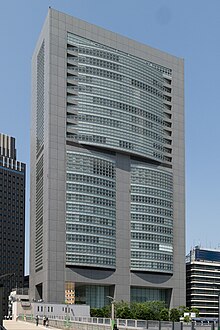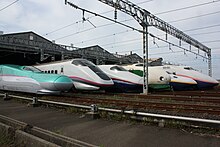East Japan Railway Company
 | |
 The company headquarters in Shibuya ward, Tokyo | |
Native name | 東日本旅客鉄道株式会社 |
|---|---|
Romanized name | Higashi-Nihon Ryokaku Tetsudō kabushiki gaisha lit. 'East Japan Passenger Railway Share Company' |
| Company type | Public (Kabushiki gaisha) |
| |
| Industry | Rail transport |
| Predecessor | Japanese National Railways (JNR) |
| Founded | 1 April 1987, privatization of JNR |
| Headquarters | 2-2-2 Yoyogi, Shibuya, Tokyo , Japan |
Area served | Kanto and Tōhoku regions Niigata, Nagano, Yamanashi and Shizuoka prefectures |
Key people | Tetsuro Tomita (Chairman of the Board)[1] Masaki Ogata (Vice Chairman of the Board)[1] Yuji Fukasawa (President, Representative Director)[1] |
| Products | Suica (a rechargeable contactless smart card) |
| Services | Passenger railways[2] freight services[2] bus transportation[2] other related services[2] |
| Revenue | |
| Total assets | |
| Total equity | |
| Owner | JTSB investment trusts (8.21%) Mizuho Bank (4.07%) TMTBJ investment trusts (3.97%) MUFG Bank (2.75%) Repurchased shares (2.67%) (as of 30 September 2018) |
Number of employees | 73,017 (as of 31 March 2013)[1] |
| Divisions | Railway operations[5] Life-style business[5] IT & Suica business[5] |
| Subsidiaries | 83 companies,[6][7] including Tokyo Monorail and J-TREC |
| Website | www |
| Footnotes / references [8][9] | |
| East Japan Railway Company | |||||
|---|---|---|---|---|---|
 Line up of JR East Shinkansen trains, October 2009 | |||||
| Operation | |||||
| National railway | Japan Railways Group | ||||
| Infrastructure company | Japan Railway Construction, Transport and Technology Agency | ||||
| Statistics | |||||
| Ridership | 6.169 billion per year[7] | ||||
| Passenger km | 130.5 billion per year[7] | ||||
| System length | |||||
| Total | 7,512.6 km (4,668.1 mi) [7] | ||||
| Double track | 3,668 km (2,279 mi) (49%)[7] | ||||
| Electrified | 5,512.7 km (3,425.4 mi) (73.2%)[7] | ||||
| High-speed | 1,052.9 km (654.2 mi) (14.0%)[7] | ||||
| Track gauge | |||||
| Main | 1,067 mm (3 ft 6 in) | ||||
| High-speed | 1,435 mm (4 ft 8+1⁄2 in) | ||||
| Electrification | |||||
| Main | 1,500 V DC overhead catenary 2,680.3 km (1,665.5 mi)[7] | ||||
| 20 kV AC, 50 Hz | 1,779.5 km (1,105.7 mi)[7] Conventional lines in Tohoku Joban Line (Fujishiro-Iwanuma) Mito Line | ||||
| 25 kV AC, 50/60 Hz overhead | 1,052.9 km (654.2 mi)[7] Tohoku Shinkansen (50 Hz) Joetsu Shinkansen (50 Hz) Hokuriku Shinkansen (50/60 Hz) | ||||
| Features | |||||
| No. tunnels | 1,263[7] | ||||
| Tunnel length | 882 km (548 mi)[7] | ||||
| Longest tunnel | The Seikan Tunnel 53,850 m (176,670 ft) Hokkaido Shinkansen[7] | ||||
| No. bridges | 14,865[7] | ||||
| Longest bridge | No.1 Kitakami River Bridge 3,868 m (12,690 ft) Tohoku Shinkansen[7] | ||||
| No. stations | 1,681[2] | ||||
| |||||
The East Japan Railway Company[10] is a major passenger railway company in Japan and is the largest of the seven Japan Railways Group companies. The company name is officially abbreviated as JR-EAST[11] or JR East in English, and as JR Higashi-Nihon (JR東日本, Jeiāru Higashi-Nihon) in Japanese. The company's headquarters are in Yoyogi, Shibuya, Tokyo, and next to Shinjuku Station.[2] It is listed in the Tokyo Stock Exchange (it formerly had secondary listings in the Nagoya and Osaka stock exchanges), is a constituent of the TOPIX Large70 index, and is also one of the three only Japan Railways Group constituents of the Nikkei 225 index, the other being JR Central and JR West.





History
JR East was incorporated on 1 April 1987 after being spun off from the government-run Japanese National Railways (JNR). The spin-off was nominally "privatization", as the company was actually a wholly owned subsidiary of the government-owned JNR Settlement Corporation for several years, and was not completely sold to the public until 2002.
Following the breakup, JR East ran the operations on former JNR lines in the Greater Tokyo Area, the Tōhoku region, and surrounding areas.
Lines
Railway lines of JR East primarily serve the Kanto and Tohoku regions, along with adjacent areas in Kōshin'etsu region (Niigata, Nagano, Yamanashi) and Shizuoka prefectures.
Shinkansen
JR East operates all of the Shinkansen, high-speed rail lines, north of Tokyo, except the Hokkaido Shinkansen, which is operated by JR Hokkaido.
The Tokyo–Osaka Tōkaidō Shinkansen is owned and operated by the Central Japan Railway Company (JR Central), although it stops at several JR East stations. |

|
Kanto region
These lines have sections inside the Tokyo suburban area (Japanese: 東京近郊区間) designated by JR East. This does not necessarily mean that the lines are fully inside the Greater Tokyo Area.
|

|
Koshinetsu region
|

|
Tohoku region
|

|
Services
Below is the full list of limited express and express train services operated on JR East lines as of 2022.
Shinkansen
- Asama
- Hakutaka
- Hayabusa
- Hayate
- Kagayaki
- Komachi
- Nasuno
- Tanigawa/Max Tanigawa
- Toki/Max Toki
- Tsubasa
- Yamabiko
Limited express (daytime)
- Akagi/Swallow Akagi
- Azusa
- Fuji Excursion
- Hitachi and Tokiwa
- Inaho
- Kaiji/View Kaiji/Hamakaiji
- Kusatsu
- Narita Express
- Nikkō and Kinugawa
- Saphir Odoriko/Odoriko
- Sazanami
- Shirayuki
- Shiosai
- Shōnan
- Tsugaru
- Wakashio
Limited express (overnight)
- Sunrise Izumo/Sunrise Seto (not operated by JR East, operated by JR Central and JR-West over the Tokaido Main Line, part of which JR East owns between Tokyo and Atami)[12]
Stations
During fiscal 2017, the busiest stations in the JR East network by average daily passenger count were:[13]
- Shinjuku Station (778,618)
- Ikebukuro Station (566,516)
- Tokyo Station (452,549)
- Yokohama Station (420,192)
- Shinagawa Station (378,566)
- Shibuya Station (370,669)
- Shimbashi Station (277,404)
- Omiya Station (255,147)
- Akihabara Station (250,251)
- Kita-Senju Station (217,838)
Subsidiaries

- Higashi-Nihon Kiosk - provides newspapers, drinks and other items in station kiosks and operates the Newdays convenience store chain
- JR Bus Kanto / JR Bus Tohoku - intercity bus operators
- Nippon Restaurant Enterprise - provides bentō box lunches on trains and in train stations
- Tokyo Monorail - (70% ownership stake)[14]
- East Japan Marketing & Communications
Sponsorship
JR East co-sponsors the JEF United Chiba J-League football club [citation needed], which was formed by a merger between the JR East and Furukawa Electric company teams.
Carbon emission plan
JR East aims to reduce its carbon emissions by half, as measured over the period 1990–2030. This would be achieved by increasing the efficiency of trains and company-owned thermal power stations and by developing hybrid trains.[15]
Alleged revolutionary front
The Tokyo Metropolitan Police Department has stated that JR East's official union is a front for a revolutionary political organization called the Japan Revolutionary Communist League (Revolutionary Marxist Faction). An investigation of this is ongoing.[when?][16]
Culture foundation
The East Japan Railway Culture Foundation is a non-profit organization established by JR East for the purpose of developing a "richer railway culture".[17] The Railway Museum in Saitama is operated by the foundation.
Bids outside Japan
JR East holds a 15% shareholding in West Midlands Trains with Abellio and Mitsui that commenced operating the West Midlands franchise in England in December 2017.[18][19] The same consortium has also been listed to bid for the South Eastern franchise.[20][21]
References
- ^ a b c d East Japan Railway Company. "JR East 2013 Annual Business Report (Japanese)" (PDF). Archived from the original (PDF) on 13 November 2013. Retrieved 25 June 2013.
- ^ a b c d e f East Japan Railway Company. "JR East Corporate Data". Retrieved 27 August 2023.
- ^ a b East Japan Railway Company. "Financial Report 2023" (PDF). p. 3. Retrieved 27 August 2023.
- ^ a b c d e f East Japan Railway Company. "Financial Highlights - East Japan Railway Company and Subsidiaries" (PDF). Retrieved 31 January 2023.
- ^ a b c East Japan Railway Company. "Organization". Retrieved 20 June 2009.
- ^ East Japan Railway Company. グループ会社一覧 (in Japanese). Retrieved 20 June 2009.
- ^ a b c d e f g h i j k l m n o East Japan Railway Company. 会社要覧2008 (PDF) (in Japanese). Retrieved 20 June 2009.
- ^ East Japan Railway Company. "Consolidated Results of Fiscal 2011 (Year Ended 31 March 2011)" (PDF). Retrieved 27 April 2011.
- ^ East Japan Railway Company. "JR East 2012 Annual Report" (PDF). Retrieved 16 February 2013.
- ^ 東日本旅客鉄道株式会社, Higashi-Nihon Ryokaku Tetsudō kabushiki gaisha
- ^ East Japan Railway Company. "JR-EAST – East Japan Railway Company". Retrieved 1 October 2016.
- ^ Michael Lambe. "The Sunrise Seto & Sunrise Izumo – Overnight Sleeper Trains from Osaka to Tokyo". Retrieved 31 March 2020.
- ^ "各駅の乗車人員 2020年度 ベスト100:Jr東日本".
- ^ HighBeam[dead link]
- ^ 'JR East Efforts to Prevent Global Warming' in Japan Railway & Transport Review No. 51 (pp. 22–27), Retrieved 2010-12-15
- ^ Government of Japan. 第174回国会 430 革マル派によるJR総連及びJR東労組への浸透に関する質問主意書
- ^ East Japan Railway Culture Foundation. "FOR A RICHER RAILWAY CULTURE". Archived from the original on 12 October 2007. Retrieved 28 October 2007.
- ^ More seats for rail passengers as nearly £1 billion is invested in Midlands services Department for Transport 10 August 2017
- ^ West Midlands Trains announced as winning bidder for West Midlands franchise Abellio 10 August 2017
- ^ West Coast Partnership and South Eastern rail franchise bidders Department for Transport 22 June 2017
- ^ South Eastern franchise bidders announced Railway Gazette International 22 June 2017
External links
- Official website
- JR East official apology for "Inaho No.14" accident on 25 December 2005
- "Company history books (Shashi)". Shashi Interest Group. April 2016. Wiki collection of bibliographic works on East Japan Railway Company




